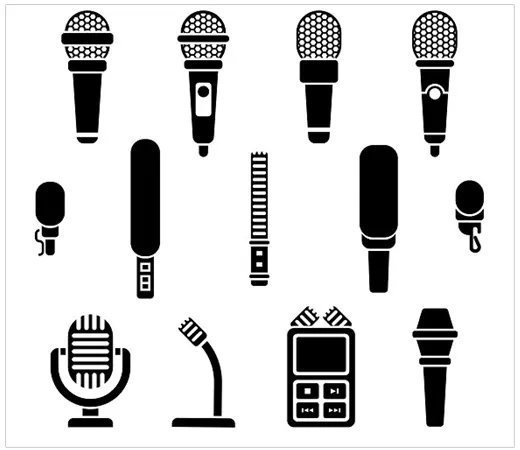
When planning to start a home or professional recording studio, you will need to look for a professional microphone if you want to get the job done correctly. However, getting the right microphone isn’t that easy, especially when considering how the market is flooded with different microphones.
Today, mics come in different designs, making it harder to identify why they were designed. However, there are some specific words that you can use to determine the microphone that’s best suited for your needs. With that said, let’s look at the different types of microphones.
Dynamic Microphones
Dynamic microphones produce excellent sound reproduction that can handle high sound pressure levels. Basically, dynamic ones are designed with a diaphragm that uses a coil and magnet.
When the electric signal is passed through the coil, it creates a varying magnetic field, making the diaphragm move and create sound vibrations. The design of most outdoor speakers come with this type of microphone built-in, and they tend to be better than most indoor speakers in terms of responsiveness and sensitivity to frequency changes.
Benefits of Dynamic Microphones
- It can sustain high sound pressure levels; hence they are perfect for stages, home theater systems, and karaoke bars.
- Highly responsive to frequency changes since the microphone’s diaphragm is built with lightweight material.
- Since they are durable, you can use them outdoors without worrying about damage due to weather conditions.

Statistics of North American Microphone Market from the year 2020 to 2030.
Condenser Microphones
Condenser mics need a power supply to function—this can be from phantom power or battery. The phantom power is then converted into electrical energy used to power the mic when recording—and this gives condenser mics higher sensitivity, lower noise levels, and greater broadband frequency response.
However, it also makes them more expensive than other mics because they are delicate equipment that requires careful handling.
Benefits of Condenser Microphones:
- DPA Condenser Microphones specifications allow the mics to deliver excellent sound pressure levels since they can pick up small details in the recorded audio.
- Require very little power supply to work; hence you can record professional-grade recordings with them even when there is no external source of power.
- The diaphragm of these mics is light, making it possible for them to be more responsive and sensitive than other types—they also tend to be smaller compared to dynamic mics.
Ribbon Microphones
Ribbon microphones reproduce sound signals in high fidelity due to their unique design. These feature a thin metal ribbon moved by two magnets—one below and one above the metal ribbon—which creates vibrations within the diaphragm when electricity flows through the ribbon.
This type of microphone is uncommon and can be used in studio recordings, but it isn’t as sensitive as other mics.
Benefits of Ribbon Microphones
- Create beautiful sound clarity due to their unique design, which can be heard at high frequencies.
- They are good at reproducing a natural tone, so they are often preferred for studio recordings and other applications where clear sound reproduction is desired.
- Since they have a larger diaphragm, it’s not easy to overload them—this means that you can get consistent results across different recording sessions without worrying about distortion or low signal levels.

Graph showing the share of Global Microphone Market in the year 2021.
Digital Recording Microphones
Digital recording microphones include USB and wireless ones; they use an analog-to-digital converter (ADC) to capture sound signals and transfer them to a digital format for processing.
Benefits of Digital Recording Microphones
- Produce high-quality sound results because of the edge reduction possible due to the direct digital recording—meaning that you have less noise distortion.
- They are easy to use since they are fairly straightforward, and most models only work with USB connections; no need for an extra mic preamplifier unit to plug into your computer or laptop.
- The size of these mics is small and easily portable, which allows you to take them anywhere and record professional-quality recordings without much effort.
Shotgun Microphones
Shotgun microphones are designed to be mounted on tripods for film and video production. They work by directing all sound signals from one point toward the diaphragm at the front end of the mic, during the time canceling noise coming from other directions.
This makes it possible to pick up sounds from specific sources, such as movie stars, during interviews without having too much background noise in your recordings. If you want to shoot videos as a hobby, you can buy one of the best alternatives.
Benefits of Shotgun Microphones
- They are very sensitive and have a response range evenly distributed across the entire spectrum.
- Have high directionality to pick up sound signals from a single point with minimal background noise.
- They are good for videography because you can easily mount them on tripods or other mounts that help film production—they also work well when used for recording audio during live music shows, sporting events, and panel discussions.
That said, these were the different types of microphones to choose from. Read everything about them and make a final decision of which one of these suits you the best.







